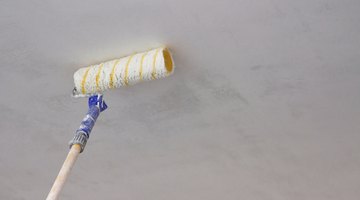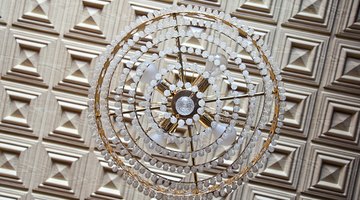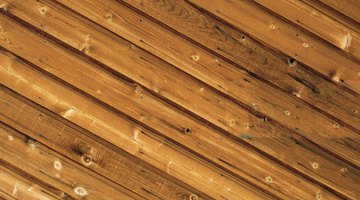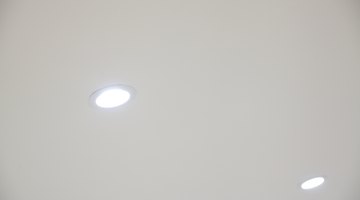Ideas to Hide Bad Ceilings
Drywall or paint defects on the ceiling are often more noticeable than those same blemishes would be if they were on the walls. Poorly taped seams create visible lines that attract attention, especially when they run parallel to the sightline.

Defects aren't always accidental; for example, you may be ruing the day you applied that Spanish knife texture, which looked good once but now, somehow, doesn't. Texture, paint, lighting, tiles and decorations can all help hide defects.
Texture and Flat Paint

Poorly taped joints show up most readily on smooth ceilings, and drywall professionals often resort to texturing to hide them. It doesn't correct the flaws, but it disperses light so that the shadow line formed by the seam isn't as visible. Skip-trowel texture, in which you spray texture in blotches and then flatten with a drywall knife, and slap-brush texture, in which you apply the texture with a paint roller and a special brush, are two relatively easy-to-apply coatings. Add a coat of flat ceiling paint to absorb light and minimize shadows even more.
Hanging Tin Tiles

Sometimes, texturing is the problem; you may be looking for an alternative to removing a texture, which is a time-consuming and messy job. Tin tiles provide a stylish solution that works especially well in dining rooms. You can install a suspended metal or PVC grid from which to hang the tiles; this ensures a flat ceiling, although it does lower it by a few inches. Because tin is a lightweight material, you can also buy tiles that you can glue and screw directly to the ceiling. This type of ceiling requires a border; you can use either wood or metal trim.
Wood Ceiling Paneling

If your house doesn't have enough wood paneling, you can always correct that deficiency by installing paneling on the ceiling. Wood is quite a bit heavier than tin, so you need to screw it directly to the ceiling joists. To avoid allowing drywall-covered walls to become overbearing, consider covering one of the walls with the same paneling you use on the ceiling. If your decor theme is already established, tie in the paneling by painting it. Otherwise, consider the paneling a feature and decorate around it. Either way, it solves the ceiling problem.
Lighting, Medallions and Hangings

One way to camouflage a ceiling punctuated by drywall joint lines -- at least at night -- is to replace pendant lights with recessed or track lighting. This eliminates light shining onto the ceiling from below. If you have a problem spot, you can cover it with a lightweight polyurethane ceiling medallion, the type that is usually used to highlight chandeliers. If the problem isn't in the center of the ceiling, you may need two medallions for symmetry. You can also mask bad spots by hanging items from the ceiling, such as an umbrella or a mobile. Like medallions, you may need more than one for symmetry.
The Drip Cap
- Drywall or paint defects on the ceiling are often more noticeable than those same blemishes would be if they were on the walls.
- You can install a suspended metal or PVC grid from which to hang the tiles; this ensures a flat ceiling, although it does lower it by a few inches.
- Otherwise, consider the paneling a feature and decorate around it.
- Either way, it solves the ceiling problem.
- If the problem isn't in the center of the ceiling, you may need two medallions for symmetry.
References
Writer Bio
Chris Deziel has a bachelor's degree in physics and a master's degree in humanities. Besides having an abiding interest in popular science, Deziel has been active in the building and home design trades since 1975. As a landscape builder, he helped establish two gardening companies.
Photo Credits
- Travis Manley/Hemera/Getty Images
- Travis Manley/Hemera/Getty Images
- Eillen/iStock/Getty Images
- pabkov/iStock/Getty Images
- Photodisc/Photodisc/Getty Images
- JaysonPhotography/iStock/Getty Images
More Articles


